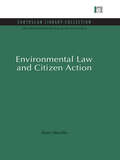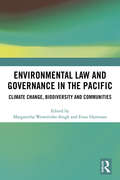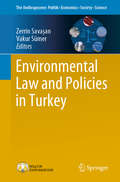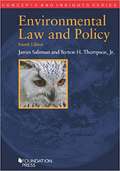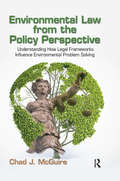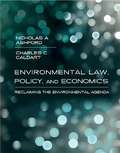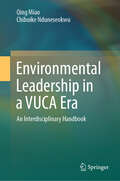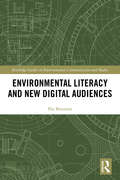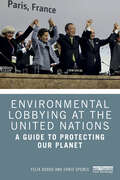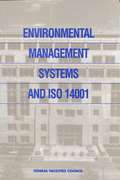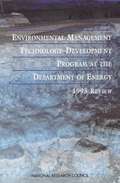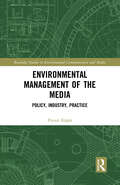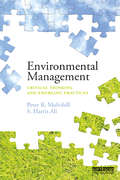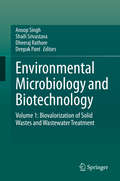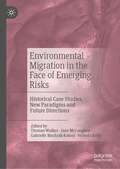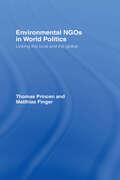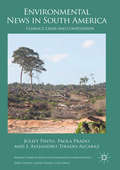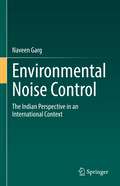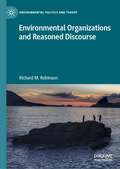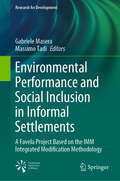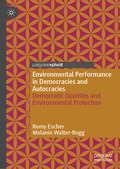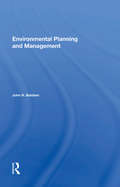- Table View
- List View
Environmental Land Use Planning and Management: Second Edition
by John RandolphSince the first publication of this landmark textbook in 2004, it has received high praise for its clear, comprehensive, and practical approach. The second edition continues to offer a unique framework for teaching and learning interdisciplinary environmental planning, incorporating the latest thinking, newest research findings, and numerous, updated case studies into the solid foundation of the first edition.The book has been reorganized based on feedback from instructors, and contains a new chapter entitled "Land Use, Energy, Air Quality and Climate Change." Throughout, boxes have been added on such topics as federal laws, state and local environmental programs, and critical problems and responses.This new edition addresses three broad subject areas. Part I, "Environmental Planning and Management," provides an overview of the field, along with the fundamentals of land use planning, and presents a collaborative approach to environmental planning. Part II, "Sustainable Land Use Principles and Planning Analysis," considers environmental and geospatial information; soils, topography, and land use; stream flow, flooding, and runoff; stormwater management and stream restoration; groundwater hydrology; landscape ecology; wildlife habitats and biodiversity; energy, air quality and climate change; and methods for land analysis. Part III, "Managing Watersheds, Ecosystems and Development to Achieve Sustainable Communities," explains the principles of ecosystem management, restoration, and protection; land conservation; and the mitigation of natural hazards.With this thoroughly revised second edition, Environmental Land Use Planning and Management maintains its preeminence as the leading textbook in its field.
Environmental Law And Policy (Concepts And Insights)
by James Salzman Barton ThompsonEnvironmental Law and Policy is a user-friendly, concise, inexpensive treatment of environmental law. Written to be read pleasurably rather than used as a dry reference source, the authors provide a broad conceptual overview of environmental law while also explaining the major statutes and cases. The updated text also describes initiatives launched by the Trump administration. The first part of the book provides an engaging discussion of the major themes and issues that cross-cut environmental law. The second part of the book examines the substance of environmental law, with separate sections on each of the major statutes. The third part of the book describes natural resources law, discussing endangered species conservation, wetlands protection, water and energy issues. Part four addresses environmental impact statements and the National Environmental Policy Act. The book has wide adoption, not only in law schools, but also in graduate and undergraduate classes outside law school.
Environmental Law and Citizen Action: Environmental Law And Citizen Action (Environmentalism and Politics Set)
by Alan MurdieNever before have people been so aware of the importance of sound environmental law, as every week stories of controversial planning developments and prosecutions for the release of toxic substances feature in the news. Environmental Law and Citizen Action sets out and explains the ways that ordinary citizens can use the law to ensure the environment is protected. There are a number of existing UK laws which require local authorities to control pollution and protect the environments and many more which can be used to tackle environmental offenders, yet often local government officers themselves are unaware of the full scope of their powers. Writing in a clear, accessible style, Alan Murdie explains how to get access to the relevant information, participate in public enquiries, use the courts to challenge public and government bodies and prosecute polluters. This book maps a path through the intricate legal maze to show what rights every citizen has, and how those rights can be enforced. Alan Murdie is a barrister with long-standing interest and involvement in local government issues, and a lecturer at Thames Valley University. He is co-author of To Pay or Not To Pay, a best-selling analysis of the poll tax debate, and has contributed to a wide range of legal and government periodicals. Originally published in 1993
Environmental Law and Governance in the Pacific: Climate Change, Biodiversity and Communities
by Margaretha Wewerinke-Singh Evan HammanThis volume examines environmental law and governance in the Pacific, focusing on the emerging challenges this region faces. The Pacific is home to some of the world’s most astonishing biological and cultural diversity. At the same time, Pacific Island nations are economically and technically under-resourced in the face of tremendous environmental challenges. Destructive weather events, ocean acidification, mining, logging, overfishing, and pollution increasingly degrade ecosystems and affect fishing, farming, and other cultural practices of Pacific Islanders. Accordingly, there is an urgent need to understand and analyse the role of law and governance in responding to these pressures in the Pacific. Drawing on academic and practitioner expertise from the Pacific region, as well as Europe and the United States, this unique collection navigates the major environmental law and governance challenges of the present and future of the Pacific. Environmental Law and Governance in the Pacific discusses 21 Pacific Island countries and territories, including Cook Islands, Fiji, Papua New Guinea, Solomon Islands, Vanuatu, and Samoa, and a broad range of themes, such as deep-sea mining, wetlands and mangroves, heritage, endangered species, human rights, and access to justice, are addressed, thus providing a comprehensive and state-of-the-art overview of environmental law and governance within specific jurisdictions as well as across the Pacific region as a whole. This volume will be essential reading for students and scholars interested in environmental law and governance in the Pacific region, as well as policy-makers, practitioners and NGOs involved in the development and implementation of environmental law and policy.
Environmental Law and Policies in Turkey (The Anthropocene: Politik—Economics—Society—Science #31)
by Vakur Sümer Zerrin SavaşanThis book aims to provide a general systematic analysis of key issues of Turkish environmental law and policies and to highlight the related concerns and challenges. Its chapters provide a historical perspective and general understanding of the legal settings of Turkish Environmental Law; offer an overall understanding of the evolving and prevailing paradigms of legislation and administrative practices in environmental policy in Turkey; explain how EIA has become the main environmental management tool and instrument of environmental compliance in Turkey; discuss the project process, challenges and results of the EU-funded project ‘Turkey’s Map of Environmental Violations’ and food security in Turkey; and present a picture of environmental justice movements from bottom-up over the establishment and operation of small-scale hydroelectricity power plants.Thus, with its comprehensive coverage of up-to-date information and findings enabling the reader to understand the topic in full analyses of key themes in Turkish environmental law and policies, addressing, in separate chapters, concepts like environmental justice, food security, environmental compliance, environmental impact assessment (EIA), and environmental cases in Turkey in detail multidisciplinary approach enabling readers to learn about the topic in a holistic mannerit aims to be:• a valuable source of information about Turkish environmental law and policies• an effective tool to support teaching and research on Turkish environmental law and policies• an aid to decision-making on Turkish environmental issues• an important resource for graduate and postgraduate research students and policymakers working on Turkish environmental law and policies Given there is no competitive book on the market with similar coverage, it makes a meaningful contribution to Turkish environmental scholarship
Environmental Law and Policy (Concepts and Insights)
by James Salzman Barton H. ThompsonEnvironmental Law and Policy is a user-friendly, concise, inexpensive treatment of environmental law. Written to be read pleasurably rather than used as a dry reference source, the authors provide a broad conceptual overview of environmental law while also explaining the major statutes and cases. A series of problem exercises have been added throughout the book, describing a legal or policy conflict in detail and asking students to identify and assess solutions. The first part of the book provides an engaging discussion of the major themes and issues that cross-cut environmental law. The second part of the book examines the substance of environmental law, with separate sections on each of the major statutes. The third part of the book describes natural resources law, discussing endangered species conservation, wetlands protection, water and energy issues. Part four addresses environmental impact statements and the National Environmental Policy Act.
Environmental Law from the Policy Perspective: Understanding How Legal Frameworks Influence Environmental Problem Solving
by Chad J. McGuireMost books on environment law focus on the law first, and then look at how environmental problems are dealt with in relation to the law. Taking a fresh approach, Environmental Law from the Policy Perspective: Understanding How Legal Frameworks Influence Environmental Problem Solving examines environmental problems first, followed by an examination
Environmental Law, Policy, and Economics: Reclaiming the Environmental Agenda
by Charles C. Caldart Nicholas A. AshfordTraces important legal, economic, and scientific developments in the environmental field through an examination of environmental law cases and commentaries by leading scholars, focusing on pollution prevention and control and emphasizing the evaluation, design, and use of the law to stimulate technological change and industrial transformation.
Environmental Leadership in a VUCA Era: An Interdisciplinary Handbook
by Qing Miao Chibuike NduneseokwuAmidst the escalating Triple Planetary Crisis—climate change, biodiversity loss, and pollution—traditional leadership approaches are no longer sufficient. Environmental Leadership in a VUCA Era presents a transformative vision for addressing these complex, interconnected global challenges. The book is structured to support both academic inquiry and practical application, featuring contributions from diverse disciplines, including environmental philosophy, environmental science, environmental management, environmental psychology, leadership, management, organizational psychology, public administration, and education. Drawing on rich philosophical traditions, it examines humanity’s relationship with the natural world and our moral responsibilities to protect ecosystems for future generations. Additionally, it highlights influential figures and organizations that have become beacons of hope and catalysts for change, demonstrating the power of collective action and sustained commitment. This comprehensive handbook provides insights into effective environmental leadership, governance strategies, and educational approaches, equipping readers with the knowledge and skills necessary to lead impactful environmental initiatives across public, private, and non-profit sectors. Designed for students, educators, researchers, policymakers, and practitioners, this book is an essential resource for fostering sustainability and developing the next generation of environmental leaders worldwide.
Environmental Literacy and New Digital Audiences (Routledge Studies in Environmental Communication and Media)
by Pat BreretonEnvironmental literacy and education is not simply a top-down process of disseminating correct attitudes, values and beliefs. Rather, it is one that incorporates and facilitates a dialogue with audiences of different persuasions and at all levels of engagement, to help highlight and co-produce consensual solutions to the major eco-challenges of our time. Exploring the growing power and influence of media formats and outlets like YouTube and gaming, alongside fictional and documentary film, this book considers new modes of environmental literacy to ascertain the effectiveness of digital and filmic stimuli on an audience’s perception of environmental issues, and its specific impact on environmental action. Drawing on extensive research across a broad range of media formats, Brereton establishes how environmental narratives and meanings are created and being received by contemporary audiences. This book will be of great interest to students and scholars of environmental communication and media, eco-criticism and environmental humanities more broadly.
Environmental Lobbying at the United Nations: A Guide to Protecting Our Planet
by Felix Dodds Chris SpenceThis book provides a step-by-step, insiders’ guide on how to lobby and engage successfully at the United Nations. It reveals how the United Nations, which plays such a key role on issues from climate change to pollution of our air, land and sea, really works.In a world of rapid climate change, a flood of forever chemicals and plastic pollution, and the extinction of so much wildlife around the world, we need the convening power of the United Nations now more than ever. What’s more, we need individuals and organisations dedicated to making sure the United Nations has the most positive impact it can. And yet, global diplomacy can be dauntingly challenging and complex. Drawing on the authors' combined 60 years of professional experience with the United Nations system, this book contains essential information for individuals and organisations seeking to engage in this complex and confusing world. From the very basic question of how to ensure you can even attend the event, this book offers hard-to-find information to help readers through this labyrinth, including insider acronyms and language, how and when are the best times to put your issue forward to achieve maximum impact, how the negotiations really work, who are the key players and how to engage with those players. The authors reveal how stakeholders can be effective from the very first day of their first UN meeting. Drawing on interviews with other experts, as well as training materials that have been produced by the authors, this book demystifies what to many outsiders can seem like an opaque and confusing world.This book is an essential resource for individuals and organisations entering the world of the United Nations for the first time, as well as those looking to gain a deeper understanding of how the world of international diplomacy really works.
Environmental Management Systems and ISO 14001
by National Research Council Federal Facilities Council Division On Engineering Physical Sciences Commission On Engineering Technical SystemsIn 1996, the Federal Facilities Council (FFC), which operates under the aegis of the National Research Council, established a standing committee on Environmental Engineering with the express purpose of providing a forum where federal environmental engineers and program managers could meet on a regular basis to exchange information about facilities-related environmental programs, policies, and issues. The committee members, like environmental program managers in other types of organizations, are increasingly concerned about achieving and demonstrating sound environmental performance by meeting the requirements of environmental regulations and limiting the impacts of their products or services on the environment. To foster communication and address concerns about EMSs, the FFC Standing Committee on Environmental Engineering hosted a one-day workshop on Environmental Management Systems and ISO 14001. The workshop was held April 9, 1998, at the National Academy of Sciences in Washington, D.C.
Environmental Management Technology-Development Program at the Department of Energy 1995 Review
by Committee on Environmental Management TechnologiesThis book provides the National Academy of Sciences' 1995 review of the technology development program for the remediation of the Department of Energy's weapons complex facilities. It makes scientific, technical, and programmatic recommendations to strengthen technology development within DOE and ensure that it meet its goals of cost effectiveness, safety, and decreased risk. The recommendations address DOE's five focus areas: landfill stabilization; contaminant plume containment and remediation; facility transitioning, decommissioning, and final disposition; mixed waste characterization treatment; and high-level waste in tanks. The book also addresses technologies in areas that cross cut the above focus area programs, namely characterization monitoring and sensor technologies, efficient separations and processing, robotics, and waste disposal.
Environmental Management in Ski Areas: Procedure - Requirements - Exemplary Solutions (SpringerBriefs in Environmental Science)
by Ulrike Pröbstl-Haider Monika Brom Claudia Dorsch Alexandra Jiricka-PürrerThis book raises awareness of environmentally friendly and resource-sparing management of winter sports areas, in order to increase the number of certified ski areas. Many ski areas today are advertised with seals of approval, titles and awards. Often, however, it is unclear which institutions and criteria are behind these appraisals. This practice is widely criticized as “green-washing”, since a cautious use of ecologically and scenically sensitive mountain areas is more important now than ever. An environmental management system based on international or European standards ensures “real” improvements and external evaluation, but relies on the personal responsibility of the providers rather than on regulations imposed by authorities. This book contributes to developing a trustworthy and unified system for such evaluation, and one that can be applied internationally.
Environmental Management of the Media: Policy, Industry, Practice (Routledge Studies in Environmental Communication and Media)
by Pietari KääpäIn recent years the widely held misconception of the media as an ‘ephemeral’ industry has been challenged by research on the industry’s significant material footprint. Despite this material turn, no systematic study of this sector has been conducted in ways that considers the role of the media industries as consumers and users of a range of natural resources. Filling this gap, Environmental Management of the Media discusses the environmental management of the media industries in the UK and the Nordic countries. These Nordic countries, both as a set of small nations and as a regional constellation, are frequently perceived as some of the ‘greenest’ in the world, yet, not only is the footprint of the media industries practically ignored in academic research, but the very real stakes of the industries’ global impact are not comprehensively understood. Here, the author focuses on four key areas for investigating the material impact of Nordic media: (1) resources used for production and dissemination; (2) regulation of the media; (3) organizational management; and (4) labour practices. By adopting an interdisciplinary perspective that combines ecocritical analysis with interrogation of the political economy of the creative industries, Kääpä argues that taking the industries to task on their environmental footprint is a multilevel resource and organizational management issue that must be addressed more effectively in contemporary media studies. This book will be of great interest to students and scholars of media, communication and environmental studies.
Environmental Management: Critical thinking and emerging practices
by S. Harris Ali Peter R. MulvihillThe field of Environmental Management (EM) involves a broad and evolving repertoire of practices. The field originated around 1970 in response to new policy, regulation and public concern about environmental issues. EM has undergone many changes and improvements since then, progressing from a reactive, compliance-based focus toward, in leading cases, practices reflecting strong commitment to sustainability. And yet, EM remains, for the most part, ill-equipped to deal with the complex and highly uncertain implications of the ecological crisis. Environmental Management offers a rigorous critique of conventional EM and explores alternative ideas, frameworks and approaches that are currently considered "fringe", but which have the potential to transform the practice of EM. This book goes beyond narrow definitions and considers questions regarding the purpose, roles, scope and potential of environmental management. EM is situated and contextualized within the evolving and expanding realm of environment and sustainability literature. The book argues that new approaches to EM need to be more flexible, imaginative and better equipped to address future environmental problems of a scale and severity previously unforeseen. This book will be of great interest to students and scholars of environmental management, environmental planning, resource management, and environmental assessment.
Environmental Microbiology and Biotechnology: Volume 1: Biovalorization of Solid Wastes and Wastewater Treatment
by Anoop Singh Dheeraj Rathore Deepak Pant Shaili SrivastavaThis book provides up-to-date information on the state of the art in applications of biotechnological and microbiological tools for protecting the environment. Written by leading international experts, it discusses potential applications of biotechnological and microbiological techniques in solid waste management, wastewater treatment, agriculture, energy and environmental health. This first volume of the book “Environmental Microbiology and Biotechnology,” covers three main topics: Solid waste management, Agriculture utilization and Water treatment technology, exploring the latest developments from around the globe regarding applications of biotechnology and microbiology for converting wastes into valuable products and at the same time reducing the environmental pollution resulting from disposal. Wherever possible it also includes real-world examples. Further, it offers advice on which procedures should be followed to achieve satisfactory results, and provides insights that will promote the transition to the sustainable utilization of various waste products.
Environmental Migration in the Face of Emerging Risks: Historical Case Studies, New Paradigms and Future Directions
by Thomas Walker Victoria Kelly Jane McGaughey Gabrielle Machnik-KekesiThis book will provide a space for new and emergent research in environmental migration, particularly in the context of a world beginning to emerge from the grip of a debilitating public health crisis that kept many firmly rooted in place while displacing others internationally. With famines, vast wildfires, droughts, and record heatwaves uprooting human settlements internationally, research on migration in the face of emerging risks is all the more urgent. As Balsari, Dresser, & Leaning point out, “the wall-building, xenophobic, and insular” platforms of some global powers in their immigration and asylum policies, and the ever-increasing stresses placed on the natural world that continue to make sites of human settlement less and less hospitable, make research on this topic both very timely and much needed. This book will include numerous case studies, historical analyses, projections, models, and recommendations for both policy and future research directions. Contributions are drawn from academics and practitioners in this fertile interdisciplinary field of academic inquiry, and each one focuses on the intersection of population and environment studies, history, geography, law, diaspora studies, economics, public health, and sociology.This book is composed of five clear sections. The introductory section includes one chapter that presents an overview of the current landscape, the scope and objectives of the book, as well as its specific approach and the various themes. The concluding section is composed of one chapter that presents a global map of recent innovations drawing together some of the core themes discussed throughout the book. The concluding chapter synthesizes the challenges and opportunities presented, and the possible future directions that researchers, practitioners, and regulators could and should move towards.
Environmental NGOs in World Politics: Linking the Local and the Global
by Thomas Princen Matthias FingerAt a time when states are reactive, at best, to the global ecological crisis and when economic globalization seems to be significantly contributing to the acceleration of that crisis, environmental non-governmental orgainisations (NGOs) are proliferating. This book explains the key role of NGOs in an emerging world environmental politics, showing how NGOs act both as independent bargainers and as agents of social learning, to link biophysical conditions to the political realm at both the local and global levels.Throught the use of case studies the authors reveal the richness and diversity of NGO activity and the dificulty of the choices facing decision-makers in their attempts to protect the environment, seek new forms of governance and foster social environmental learning. The book generates questions that are central, not only to an understanding of NGO relations, but to the study of international environmental politics.Environmental NOGs in World Politics will be of great interest to upper level student sand scholars of both environmental politics and international relations. It will also appeal to environmental-policy professionals.
Environmental News in South America
by Juliet Pinto Paola Prado J. Alejandro Tirado-AlcarazCombining perspectives from media studies and political ecology, this book analyses socially constructed news regarding three environmental conflicts in South America. In recent decades, South American political administrations have tied national economies to neo-extractive development strategies, creating not only vulnerabilities to global commodity boom and bust pricing cycles, but also to conflict regarding environmental and cultural degradation from extraction activities. Environmental contestations among indigenous peoples, environmental and social NGOs, state actors, and extraction industries receive media attention, but how these disputes are covered has implications for understandings of media performance in democratizing nations. The authors examine three case studies of environmental contestation in a region that is simultaneously vulnerable to the effects of climate change, and yet has become once again dependent on commodity exportation to industrializing and industrialized nations for economic benefit and social development strategies.
Environmental Noise Control: The Indian Perspective in an International Context
by Naveen GargThis book provides a concise and up-to-date overview of environmental noise control issues, utilizing specific case studies from India to help explore noise mapping and monitoring, impact analysis, and policy, among other relevant topics. The book provides an extensive review of recent studies, including references, and describes the latest noise monitoring structures. It also addresses heretofore under-emphasized topics, including but not limited to acoustic metrology, Multi Attribute Decision Making (MADM) techniques, and sound insulation utilizing passive control strategies.
Environmental Organizations and Reasoned Discourse (Environmental Politics and Theory)
by Richard M. RobinsonThis book explores the meaning and role of “fair and reasoned discourse” in the context of our institutions for environmental decision processes. The book reviews the roles of our “environmental advocacy organizations”—such as The Sierra Club, The Audubon Society, the Environmental Defense Fund—in providing and ensuring that our discourse and decisions are fair and reasoned according to the criteria of being (i) inclusive of input from all affected, (ii) informed of relevant scientific and socio-economic information, (iii) uncorrupted by direct conflicts of interest, and (iv) logical according robust review by uncorrupted judges. These organizations are described and examined as expressions of “collective imperfect duty,” i.e. the coordinated duties with environmental direction. The current state of our discourse is examined in light of this fairness criteria, particularly in consideration of the cross-border problems that threaten tragedies of the global commons.
Environmental Performance and Social Inclusion in Informal Settlements: A Favela Project Based on the IMM Integrated Modification Methodology (Research for Development)
by Gabriele Masera Massimo TadiThis book discusses the potential of a systemic and multidisciplinary design approach to improve urban quality, health, livability, and inclusiveness for people living in informal settlements. In most instances, attempts to address informal settlements lack an adequate assessment of their impact on the wider built environment and implementation of the UN’s Sustainable Development Goals. The Integrated Modification Methodology (IMM), introduced here, offers a systematic, multidisciplinary design tool encompassing several of the aspects that define the environmental performance of urban systems. The book also demonstrates the application of the methodology to an informal settlement, proving its potential to guide systemicurban transformations, also in urban areas lacking formal planning. The case study investigated is in the Rocinha favela in Rio de Janeiro, which ischaracterized by poor water quality, lack of drainage and sanitation systems, and very few green spaces. Based on a rigorous methodology, the process described here can also be applied in similar contexts around the world.
Environmental Performance in Democracies and Autocracies: Democratic Qualities and Environmental Protection
by Romy Escher Melanie Walter-RoggThere are considerable differences in environmental performance and outcomes across both democracies and autocracies, but there is little understanding of how levels of democracy and autocracy influence environmental performance. This book examines whether analysing the effects of individual democratic features separately can contribute to a better understanding of cross-national variance in environmental performance. The authors show that levels of social equality in particular, as well as the strength of local and regional democracy, contribute significantly to explaining cross-national variation in environmental performance. On the other hand, a high level of political corruption affects a country’s ability to adopt and implement environmental policies effectively. In exploring the inter-relationship between democratic qualities, political corruption, and environmental performance, this book presents policymakers and political theorists with a clear picture of which aspects of democratic societies are most conducive to producing a better environment.
Environmental Planning And Management
by John H BaldwinA comprehensive overview and discussion of all major aspects of environmental planning and management, Professor Baldwin's textbook highlights the causes and interrelationships of environmental problems, emphasizing the important economic and ecological functions of the land as the stage for all human activities and the "source" and "sink" for all


